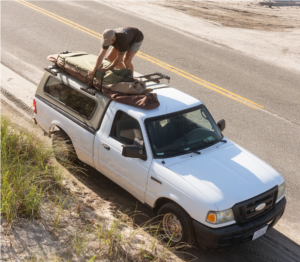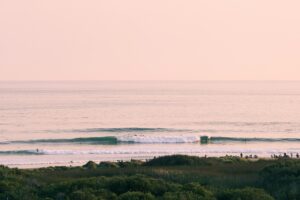Did you know, there is a 1 in 4,332,817 chance of being attacked by a shark? Well, not exactly. If you surf every day, and if you live in an area where sharks are present, this number is just as irrelevant as the “more likely to be struck by lightning comparison”. As a surfer, sharks are something always at the back of your mind, especially if you live in some of the following destinations.
I dug deep into the world shark attack statistics to look at where had the most attacks and fatalities during the past decade and back to when records began. Based on data collected by the Florida Museum, The USA, Australia, and South Africa are the countries responsible for the majority of global shark attacks. So which surf destinations are “sharkiest” and what can be done to lower your risk of an attack while surfing? Here’s everything you need to know about surfing and sharks.
Table of Contents
The World’s “Sharkiest” Surf Destinations
Recife, Brazil
Brazil likely doesn’t come to mind when you think of sharks, but Recifie, in the Pernambuco state, is one of the sharkiest surf destinations in the world. Between 1992 and 2013, there were 62 attacks, 24 of which were fatal. A third of all attacks resulted in a death. Gnarly.
Bull sharks are the most prominent species in the area and several key factors could contribute to the abnormally high number of shark attack fatalities here, Coastal development is said to have disrupted a bull shark breeding ground in the nearby river mouth, while just upstream of the same river, discharge from a slaughterhouse is another significant contributing factor.
La Reunion, Departments of France
When it comes to surfing and sharks, La Reunion is the most famous. The French Overseas Department is a stunning, tropical paradise with world-class waves such as the former CT venue, St Leu, and has produced France’s most successful surfer, Jeremy Flores.
Between 2012 and 2021, there were 19 attacks, 8 of which were fatal. Reunion holds the title for most fatal shark attacks outside of the US, Aus, and South Africa. After Elio Canestri was killed by a shark surfing down the road from his home, the island went into a shark cull/killing spree and surfing was banned outside of netted areas.
Bull sharks and Tiger sharks are the species responsible for most attacks on the island and despite the astronomical statistics, and banning of surfing, surfing is returning to the island.
California, USA
California is notorious for sharks, most notably in the State’s North. Dubbed the red triangle, the stretch of coast between Bodega Bay in the North and Point Sur to the South, are some of the sharkiest waters on the planet. This area is home to world-renowned surf sports such as Santa Cruz, and Mavericks.
With cold brown water and huge Great whites–it’s a spooky place to surf. Over the last decade, (2012-2021) there have been 29 attacks and 3 fatalities. Sharks are also present in Southern California–see the most recent shark attack data for California here.

South Carolina, USA
On the US East Coast lies a somewhat surprising destination on this list, but the stats render this area no less sharky than the ones mentioned above. South Carolina is home to several popular East Coast surf spots (including Folly and Pawleys) and between 2012 and 2021, the area has experienced 45 attacks, but 0 fatalities.
Eastern Cape, South Africa
It’s no secret that sharks are around in South Africa and the nation is one of the sharkiest surf destinations on the planet. We see them every year at the WCT event and we’ve all seen the Mick fanning incident. The Eastern Cape region of South Africa is notorious for Great White Sharks and there have been 29 attacks and 6 fatalities over the past decade (2012 – 2021). According to the ISAF, since records began (1533), there have been 129 attacks in the Eastern Cape. East Cape hosts JBay and some of South Africa’s best breaks. For surfers here, it’s on the front of everyone’s mind. I know it was for me during my 2018 trip.
Hawaii, USA
Hawaii has the title for the most famous shark attack incident Bethany Hamilton’s attack in Kauai. Hawaii has some of the best waves on the planet, a paradisical island chain from where surfing began. Despite this, there are sharks. Most recently the tragic fatality in Honolua Bay during the Women’s CT event waiting period. Across the Hawaiian islands, there were 76 attacks, 3 of which were fatal between 2012 and 2021. With Maui having the most attacks.
New South Wales, Australia
Australia is one of the sharkiest surf destinations in the world. A huge country with thousands of miles of coast, and is home to various species of sharks. The state of New South Wales has been responsible for most shark attacks in Australia and between 2012 and 2021, there have been 143 attacks, 20 of which were fatal. While there have been shacks in all areas of Australia since records began, NSW has had the most with 271 total attacks. Surf spots like Byron Bay, Forster, and Ballina are the most notorious, not just in Australia but the world.
Florida, USA
Number #1 on our list is Florida. According to the statistics, while there were not as many fatalities, Florida had the most attacks with 259 over the past decade. (2012 – 2021). While 0 have been fatal, Florida is statistically number 1 for shark bite incidents. Check out Florida’s shark attack data here.

Surfing & Sharks - Statistical Summary
Total attacks between 2012 and 2021
- Attacks: 761
- Fatalities: 60
Total Attacks
- Recife, Brazil
- La Reunion
- California
- South Carolina
- Eastern Cape, South Africa
- Hawaii, USA
- New South Wales, Australia
- Florida
Fatalities
- New South Wales, Australia
- La Reunion
- Eastern Cape, South Africa
- Recife, Brazil
- Hawaii, USA
- California
- South Carolina
- Florida
The US, Australia, and South Africa are the “sharkiest” surf destinations on Earth. So on average, there are around 50-100 shark attacks per year. But the above data refers to all water users, so what percentage of these water users were surfers? According to the Florida Museum, the overwhelming majority of shark attacks involved surface recreationists, defined as surfers, bodyboarders, and swimmers. Between 2010 and 2019, out of the 752 attacks, 544 were surface recreationists.
Shark Attack Species
Great White Sharks
Great white sharks are the most fear-inducing shark species for surfers. Great whites are visual hunters and while they can normally correctly distinguish surfers from their typical prey (seals and fish etc..), murky water makes this tricky. Great whites also prefer to attack lone surfers/swimmers.
Bull Sharks
Bull sharks are renowned for being the most aggressive shark species. They prefer to hunt and bite their prey in murky waters, usually close to river mouths.
Tiger Sharks
Tigers are the least aggressive and responsible for the fewest shark attacks on humans, Tigers still show levels of aggression found in bull sharks.

Shark Prevention Methods
Avoid Surf Spots with Sharks
Perhaps the easiest and most simple shark prevention method is not surfing where there are sharks. Sounds simple right? If you love where sharks are present, going surfing is at your own risk. If you’re scared and not enjoying your time in the water get out.
Avoid Murky Water
Murky water is where much confusion lies between surfers and sharks, where sharks mistake human surfers for seals and their preferred meals. So avoid surfing in murky water, for example, after heavy rains, or at river mouths.
Don’t Surf at Dawn/Dusk
Like with murky water, dawn/dusk, there is less visibility and sharks can mistake you for prey more easily. Additionally, sharks like to hunt during nighttime.
Don’t Surf Alone
Many sharks, especially great Whites, prefer to hunt down lone targets so surfing alone significantly increases your chances of shark attacks. Surfing with a friend or in a crowd can put sharks off from attacking.
Avoid Fish Running Periods
Sharks hunt during these times. So if you turn p to the beach and see a bait ball with birds diving out the back, that’s not a good time to surf where sharks are present.
Use Shark Deterrent Technology
Shark shields can be a great way to prevent shark attacks. These technologies, usually leg ropes or tail pads give off a magnetic signal that deters sharks. Whether they work, is up for debate and not something I’m going to jump into a murky river mouth to test. It can definitely give you and your loved ones peace of mind, but they don’t eliminate all risks. Check out SharkBanz.
Shark Spotting Apps
If you live and surf in sharky areas, using shark spotting apps such as Dorsal can be a great ay to avoid surfing and stay in the know when sharks have been spotted. These apps allow you to track shark sitings in your area and stay in the know.
Surfing & Sharks - Final Words
Sharks are a huge factor in our sport and It’s a primal fear and depending on where you surf, is always on your mind. While we can use any of the above shark prevention techniques and technologies, there is no guarantee and I think as surfers, we must accept that we are entering their territory every time we surf. It’s the risk we take to ride our precious waves and if you want to surf in the world’s “sharkiest” surf spots and sample some of these spots, it’s part of the deal. Whether it’s worth it or not, is up to you.




